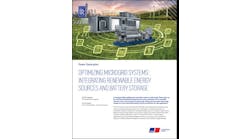Oklo Inc., the small nuclear reactor design firm backed by OpenAI founder Sam Altman, is seeing impressive early opt-in for its technology to power commercial and industrial facilities in the future.
Of course, this interest in small nuclear by the C&I sector must transition from intentions to physical reality to prove effective in spurring installment of nuclear microgrids in the future.
Oklo’s second quarter financial update reported its customer pipeline has grown 93% to 1,350 MW (1.35 GW) in the past year. Many of the customer agreements are non-binding letters of intent and term sheets that Oklo hopes to turn into power purchase agreements (PPAs) over the rest of the year and early 2025, although there are some PPA deals already committed.
Most of the new customer demand is coming from the data center industry, which is growing at a pace exceeding the utility-scale grid's ability to cover future power load, according to reports. AEP and PG&E are among the utilities reporting exponential load growth commitments from future data center projects.
Oklo, which is working on microreactors ranging from 15 MW to more than 50 MW in generation capacity, is still awaiting final U.S. Nuclear Regulatory Commission approval for a combined license. The company is planning to start construction on a fuel fabrication site on the Idaho National Laboratory grounds soon.
The customers working on signing deals with Oklo include Diamondback Energy on a PPA to electrify Permian Basin oil and gas operations, and an agreement with the U.S. Air Force to supply a microreactor that would power Eielson Base in Alaska.
Nuclear Microgrids is a Topic We Want at Microgrid Conference 2025
Happening April 15-17 at the Sheraton Dallas
Call for Speakers is Now Open: Send Your Ideas
Mission-critical entities such as military bases and data centers are increasingly considering the potential of nuclear microgrids to supply baseload, flexible and carbon-free power for operations. Companies such as Microsoft and Amazon Web Services are working on potential small modular reactor (SMR) deals for future facilities.
Earlier this summer, the U.S. Department of Energy issued a notice of intent to fund up to $900 million to support deployment of SMR technologies. All that funding is allocated from the Bipartisan Infrastructure Law passed and signed by President Biden in 2021.
The movement toward smaller nuclear power, if ever realized, could provide a baseload, decarbonized power resource that is more flexible and less intermittent than renewable energies such as solar and wind. The smaller footprint also provides a potentially more cost-effective option than expensive conventional nuclear power plants, such as the recent $32 billion Vogtle 3 and 4 project in Georgia.
Nuclear power plants provide about 19% of current U.S. utility-scale electricity generation and close to half of the carbon-free power nationally, according to reports. The Vogtle plant is the largest clean energy generator in the country.
Oklo is hoping to complete and deploy its advanced reactor demonstration by the end of the decade. Earlier this week, it announced an agreement to use components from Siemens Energy in its future power plants.
Oklo entered public share trading last year through a merger with special purpose acquisition company AltC Acquisition Corp., which was co-founded by Altman. He is also chairman of the Oklo board of directors.
Allied Market Research in March released a forecast predicting the SMR nuclear market could grow up to 9% annually and reach $13.4 billion in value by 2032. Other startups and companies in the SMR development phase include NuScale Power, GE Hitachi Nuclear Energy, X-energy, TerraPower, Natura Resources and ThorCon Power.
Other long-time nuclear energy firms exploring SMRs include Westinghouse Electric, Rolls-Royce and Russian firm Rosatom.
Not all players in the energy sector are positive about small nuclear fission as part of the microgrid generation resource mix. Many still see it as facing locational, cost and safety assurance challenges.
Track Nuclear News in the Microgrid Sector through our Tri-Weekly Newsletter








